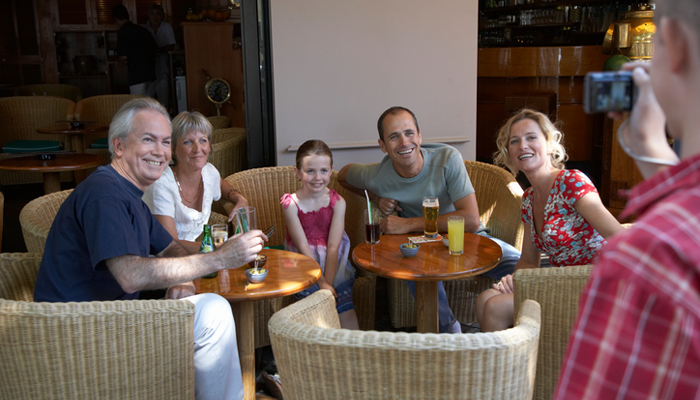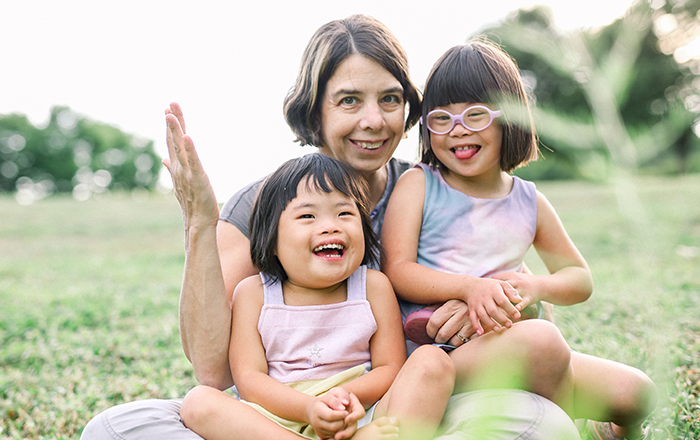My wife Laurie and I, adoptive parents of four children ages six through 13, have never met any of our kids’ birth fathers. During the foster-to-adopt process for our two boys, the relinquishment paperwork was already in process. Our two girls’ birth mothers claimed “unknown.” Both times our adoption attorney filed the paperwork for the paternal registry, I briefly fantasized about the guy—what he looked like, what kind of home life he had. However, the notion of the birth dad as a real person was too abstract for me to envision. That is, until one birth father’s family reached out to us.
When our daughter, Vivianna, was born, her birth mom, Maria (*not real name), told us she didn’t know who the birth father was. As Vivi grew, she favored her older birth sister, Ella (*not real name), who was being raised by Maria. The girls shared some distinct similarities in ethnic and facial features, as well as the same shy demeanor. But they weren’t identical, either—their complexions and hair colors were noticeably different. For a while, Maria denied they were full biological sisters. Then, when Vivi was two years old, she admitted they were. We pushed for more details about the birth dad, but Maria maintained it was better we not know. Over the years, she casually mentioned Ella’s dad from time to time, but remained vague and elusive when we asked for more information.
Opening the Door
Last March, Vivi celebrated her tenth birthday. That morning, Laurie posted a series of pics from Vivi’s childhood on Facebook. A few days later, I saw a comment in the feed from a lady I didn’t recognize: “She’s beautiful! This aunt would love to meet her one day.”
“Who’s this stranger claiming to be an aunt?” I said.
Laurie clicked on the profile. “Oh, my gosh! There’s a bunch of pictures of Ella. This must be the potential birth dad’s sister!” Laurie took screenshots of the aunt’s profile and texted Maria, “How did she get my info? How do they know our last name?”
“Don’t know,” Maria responded.
“She HAD to have given it to them,” I said to Laurie. “But still, I thought your profile was private.”
“It is,” Laurie said. She checked her settings. “I must have published this post as public. I’ll change it now.”
A few days later, we received an email from a fellow introducing himself: “Hello, my name is Alan (*not real name), and I am Vivianna’s biological father. Please don’t be alarmed. I only want to open the door of communication. If you want to talk, here’s my info.”
As we discussed how to respond, Laurie received a private message from the aunt. “PLEASE put the post back up. It’s the least you can do since we can’t see her.”
Laurie said to me, “What does she mean, ‘We can’t see her’?”
“I don’t know,” I said. “Maybe Maria told them we don’t want them to see her.”
“I’m going to reply to Alan and send his sister’s PM,” Laurie decided. “He seems like an approachable guy. Maybe we can dialogue with him.”
“Hang on,” I said. “I have to wrap my brain around this.” Laurie’s had years to process knowing that our kids’ birth mothers are real people—names, photos, some emails, and texting and meeting with Maria and Ella several times a year. This birth father thing, on the other hand, was all new to me. “I want to call our adoption attorney,” I said.
“Honey, I think you’re panicking,” Laurie said. “He can’t threaten the adoption, if that’s what you’re afraid of.”
Of course she was right. Since becoming parents over a decade ago, we’ve given multiple talks on adoption to new parents. But now, I was behaving as if I knew nothing about adoption law. Luckily, Laurie had a cooler head. She responded that we were open to having an email dialogue, and she asked several questions: When did he find out about Vivianna? How did his family find us online? What has Maria told him about us?
Alan responded and answered every question. He openly admitted he had made bad decisions 10 years ago. He explained that he had found out about Vivi when she was two, and he felt a lot of grief that he didn’t find out until it was too late. Laurie responded by sharing some of what we had been told over the years, assured him that we had hired a reputable adoption attorney to secure the adoption, and comforted him in his grief.
Taking the Next Steps
Over the next few days, Laurie and Alan swapped numerous emails. He said he was glad Vivi was our daughter, and repeatedly assured us he didn’t want any drama. All he wanted was to get to know her and introduce her to his wife and kids, and eventually some extended family.
“Does that make you feel better?” Laurie asked me.
“Sure,” I said. “So what’s the next step?”
“We tell Vivi about him, and then we set up a meeting.”
We spent at least an hour planning what to say to Vivi. When we felt confident that we’d thought of every possible reaction, we called her into our room and sat her down. “What has Ella told you about her dad?” I began.
“Not much,” she said.
“What if we told you he might also be your birth dad?”
“I wondered if he could be,” she said quietly, “But I didn’t want to ask because I didn’t want you to be mad.”
I pulled her into my lap. “Baby, we aren’t mad. You can ask us anything.” She smiled and gave me a hug. I asked, “Do you want to meet him?”
She nodded her head. Then she ran off to play with the other kids. “Well, that was easy,” Laurie said. “I thought she’d have a bigger reaction.”
“Me too,” I said.
All the Pieces Seem to Fit
Laurie set up a meeting the following week to meet Alan, his wife Hannah (*not real name), their two young kids, and his parents. We met at a chain restaurant halfway between our homes. I spent the car ride wondering what these people would be like, but when we pulled up to the restaurant and saw a small group of people waiting outside and Laurie announced, “That’s them,” I realized it hadn’t occurred to me how I should behave. Suddenly my brain flooded. How hard should I shake his hand? Should I hug his wife and mom or shake their hands? Do I start in with small talk about what we do for a living or complaining about the weather, or do I jump right in to, “So your long-lost daughter is my daughter?”
Laurie got out of the car, gave Vivi’s dress and hair a quick once-over, then reached for Vivi’s hand and led her to the small group. As we made our introductions, I felt like I was in a parallel universe, like I was meeting some sort of long-lost twin, except we looked nothing alike. I tried not to be obvious as I took Alan in—his appearance, his clothing, how he interacted with his wife and kids. Then I wondered if he was doing the same with me. I became self-conscious of everything and my mind flooded again. Why did I wear this shirt? Should I have shaved? Did I look like I made enough money to support Vivi? Did I look too rich and aloof?
After we ordered, Vivi got out of her chair and sat on my lap, which is code for “I’m nervous.” It felt good, like she was claiming me as her dad, and I hoped the family interpreted the gesture as a sign that we were well-bonded. Then I wondered if this made them sad that they were never given a chance with her.
Laurie said to Vivi, “Why don’t you tell them about fourth grade?” Vivi talked briefly about school, and Alan asked a couple of questions. Vivi’s sentences were short, and we sat in silence for a bit. It reminded me of how Vivi and Ella interact, like they’ve entered a pact to hold the world’s quietest conversation. They only see each other a couple times a year, but after a few minutes they run out of things to talk about:
I say, “You’re both cheerleaders. Why don’t you talk about that?”
Vivi quietly says, “I’m a base.”
Ella quietly says, “I’m a base too.”
“I wish I could be a flyer.”
“Me too.”
Then they sit in silence again.
Meanwhile, Laurie immediately connected with Alan’s wife and mother. Fifteen minutes after saying their first hello they’re laughing like old friends. They joked about how introverted Alan, Vivi, and I were. But as the meeting progressed, the three of us opened up more. We shared stories of the past 10 years and what Maria had told us about each other, and shared a concern about inconsistencies.
As the meeting wrapped up, Alan and his family all thanked us for the meeting and asked if we could meet again. “We had a great time and want to meet with you guys again,” Laurie said. “But I think we should do a paternity test before we go any further. Just to be sure.”
“Absolutely,” they all said.
We said our goodbyes and everyone hugged each other. Then we took a bunch of pictures, said more goodbyes, and gave hugs again. The entire goodbye process took more than 30 minutes. As we finally got in the car to drive home, Laurie said, “That couldn’t have gone any better. I really like them.”
“I liked them, too,” I said. “They were very straight-forward people.”
“Agreed,” Laurie said. “My dream for the kids has always been that we have a healthy open adoption with their birth families. None of our kids have had that until now. This is our chance for one of our kids to have a relationship with a group of people who care about her.”
“Then let’s get going on the paternity test.”
“Sure,” she said. “…but it’s gotta be them, right? I mean, look at all the pieces that fit. Alan and Ella both share Vivi’s temperament, and the girls share features.”
“Yes, but look at the differences,” I said, “Their hair, their complexion. It’s not a sure thing. We need the test to confirm before we proceed any further. It’s better for everyone involved.”
“Ok,” Laurie said. We sat in silence for a minute, then Laurie said, “I really hope it’s them.”
“Me too,” I said.



